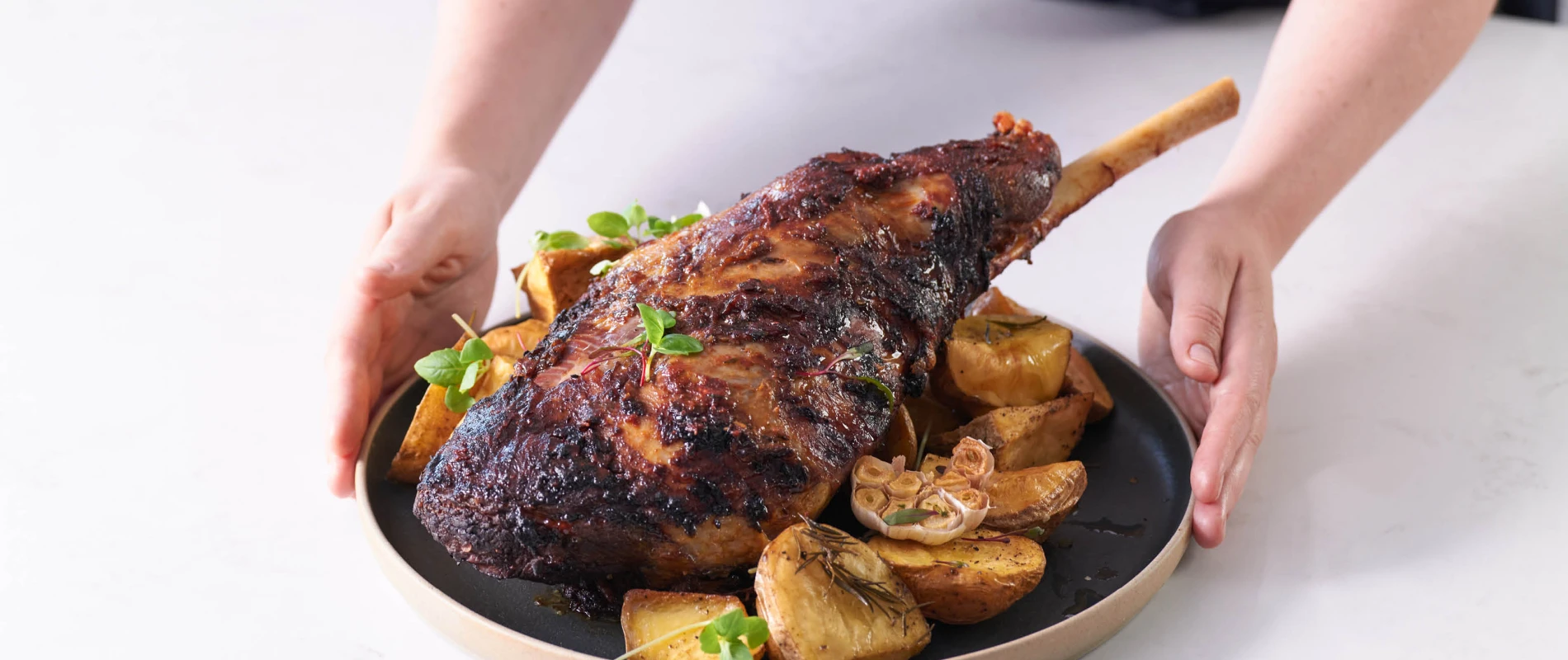
Cooking lamb for service
By Maimoa Chef Sam Parish
Like any meat, cooking lamb varies from a quick pan-to-plate, a moderate oven for 1-2 hours or a low and slow option that could take up to 6 hours. Cooking lamb perfectly is simple. We start with identifying the cut of lamb and from there determine the method of cooking. Fast or slow it all comes down to what part of the lamb we’re working with. You’ve got to work with the lamb and let it tell you how to cook it. Therefore, to get lamb consistently perfect for service, be it in a 50 Pax restaurant or an event space catering for 300-1200 pax. It’s all about timing the cut of the lamb to the job.
Lamb shoulders and legs are perfect for big functions. Cooked on the bone in advance for 4-6 hours in a low oven. Then chilled and reheated for service in a hot oven and glazed in a sticky honey soy marinade, you’ll have tender pull off the bone meat with a sticky delicious skin. The beauty of lamb is even with cooking ahead the meat keeps its pinkness and moisture and the spectacle of serving the shoulders to the table is a fantastic dining experience. Another option here is to shred the meat from the cooked shoulders and chill in portioned containers. Then for a quick pan to plate service option, sauté in a pan with aromatics and serve stuffed into a taco or burger bun or spoon over the top of a bowl of freshly cooked noodles and broth. Slow cuts can be made ahead and used in a multitude of ways.
Another great lamb cut that can go from pan to plate, with a little pre work, is the lamb rump. Place in a Sous-vide bag with aromatics then cook at 55 degrees for 1-2 hours. Chill in an ice bath and sear, slice and serve. It’s all in the prep, making it as quick as 10 minutes from taking a guests’ order to being platted on the pass. This tender cut is a must for any menu and is versatile in taking on a vast variety of flavours.
For lamb that is cooked and or roasted for service always use a meat thermometer and have your meat at room temperature before cooking. For rare lamb you want the internal temperature to be sitting at 58°C, for medium 65°C and for well-done 70°C. Especially your lamb racks and loins, keeping an eye on the temperature but also resting your meat is so important in guaranteeing a blush pink center.
Lamb can also be prepared for service without cooking
Instead of cooking to prepare lamb for service, any cut of boneless lamb can be thinly sliced and tossed in a bowl with a small amount of bicarb soda and corn starch then chilled to tenderize. For our quick cuts 1-2 hours is enough, but our shoulder and leg cuts would need at least 8 hours or overnight. This way you can be economical with the cuts you use and still achieve that tender result. A flash in a hot oiled pan and finished with a sticky sauce or grilled over coals and tossed through a salad. This way of preparing lamb can be great option of kitchens.
Don’t underestimate serving lamb raw or blue
Maimoa lamb is handled in such a way that serving it raw is sometimes the best way to eat it and get a true taste of its beautiful flavour. Using the tenderloin and dicing the lamb into small pieces then serving as a tartare is a beautiful way to respect and do the meat justice. Also removing the loin fillet from the rack and searing it in a hot pan briefly. Then freezing for 1 hour and slicing super thin for a carpaccio dish with crispy capers or take it to being fully frozen and shaving the meat to be added to hot broths. We love the versatility of Maimoa lamb.
Render the fat
Fattier cuts like the leg and the rack do well with a good rendering in the pan before cooking. Starting in a cold pan place the meat fat side down and cook over low heat until the fat gap is just 2mm in thickness or to your liking. Safe to say that fat is flavour, especially when it comes to Maimoa lamb, so keep any fat rendered in a container. This can be used to enrich a pan of sauteed veg or even mixed into pastry, noodle or pasta dough to add a new dimension of flavour.
Lamb Stock
Keep any trimmings and bones from your lamb and roast until golden brown. Transfer to a pot with vegetables, spices and herbs and let it bubble away for at least 4-6 hours, skimming from the top. Strain and chill over night to set the fat then remove and reduce the beautiful golden liquid for a jus or demi-glace. The deep lamb flavour you can achieve with a good stock is undeniably the ultimate way to round out any dish and take it to another level. It also gives opportunity for introducing flavours to the stock that might be accompanied in the dish and harmonizing the overall taste of the end plate of food.
Maimoa Lamb is a beautiful product. And while less is more, it can also handle whatever you throw at it. We hope with these tips you’ll be confident in cooking your Maimoa lamb and making it the star its born to be on every plate.


